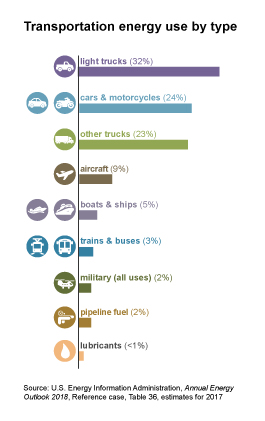The United States is a nation on the move. About 29% of U.S. energy consumption in 2017 was for transporting people and goods from one place to another.
Different types of energy sources (or fuels) are used for transportation in the United States
The major types of energy used for transportation in the United States are
- Petroleum products: products made from crude oil and from natural gas processing, including gasoline, distillate fuels (mostly diesel fuel), jet fuel, residual fuel oil, and propane
- Biofuels: ethanol and biodiesel
- Natural gas
- Electricity (produced from many different energy sources)
Energy sources are used in several major ways
- Gasoline is used in cars, motorcycles, light trucks, and boats. Aviation gasoline is used in many types of airplanes.
- Distillate fuels are used mainly by trucks, buses, and trains and in boats and ships.
- Jet fuel is used in jet airplanes and some types of helicopters.
- Residual fuel oil is used in ships.
- Biofuels are added to gasoline and diesel fuel.
- Natural gas, as compressed natural gas and liquefied natural gas, is used in cars, buses, trucks, and ships. Most of the vehicles that use natural gas are in government and private vehicle fleets.
- Natural gas is also used to operate compressors to move natural gas in pipelines.
- Propane (a hydrocarbon gas liquid) is used in cars, buses, and trucks. Most of the vehicles that use propane are in government and private vehicle fleets.
- Electricity is used by public mass transit systems and by electric vehicles.
Petroleum is the main source of energy for transportation
In 2017, petroleum products accounted for about 92% of the total U.S. transportation sector energy use. Biofuels, such as ethanol and biodiesel, contributed about 5%, and natural gas contributed nearly 3%, most of which was used in natural gas pipeline compressors. Electricity provided less than 1% of total transportation sector energy use and nearly all of that in mass transit systems.
Gasoline is the most commonly used U.S. transportation fuel
Gasoline is the dominant transportation fuel in the United States, followed by distillate fuels (mostly diesel fuel) and jet fuel. Gasoline includes aviation gasoline and motor gasoline. Motor gasoline includes petroleum gasoline and fuel ethanol added to petroleum gasoline. Fuel ethanol includes ethanol (a biofuel) and petroleum denaturants. The petroleum component of gasoline (excluding ethanol) accounted for 55% of total U.S. transportation energy use in 2017. Distillate fuels, mostly diesel, accounted for 22%, and jet fuel for 12%.
Biofuels are added to petroleum fuels
Ethanol and biodiesel were actually some of the first fuels used in automobiles but were later replaced by petroleum gasoline and diesel fuel. Today, biofuels are added to gasoline and diesel fuel. In 2017, biofuels accounted for 5% of transportation sector energy consumption, with ethanol's share at 4% and biodiesel's share at about 1%.







